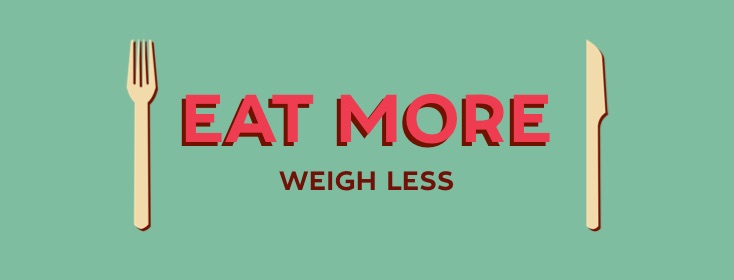Choosing High Volume Foods to Eat More and Weigh Less
Want to eat more and weigh less? The answer lies in volumetrics. Volumetrics is the principle of eating foods that contain lots of water and fiber. Water and fiber take up large amounts of space, yet do not have any calories.
By eating foods high in water and fiber, you will fill up your stomach and feel satisfied with fewer calories. This can help significantly in your weight loss goals. For example, 1 cup of watermelon has lots of water and fiber but is relatively low in calories. In contrast, just 1 tablespoon of chocolate chips has even more calories, yet almost no fiber and water. The watermelon will fill you up and satisfy you, whereas the chocolate chips will barely make a dent in your hunger.
If you’re seeing a registered dietitian nutritionist for your diabetes, you will probably learn ways to add more low-energy-density foods to your diet.
What is energy density?
- Energy density is defined as the amount of energy (calories) in a specific amount of food.
- High-energy density foods have a concentrated amount of calories per bite (think chocolate chips)
- Low-energy density, high-volume foods are foods that have fewer calories per gram than their high-energy density counterparts (think fruits and vegetables)
Eat more low-energy density, high volume foods
- fruits
- vegetables
- broth based soups
- whole grains
- lean meats
- low-fat dairy
Eat less high-energy density foods
- doughnuts and baked goods
- potato chips and most types of crackers
- dried fruit
- nuts and nut butters
- olives
- bacon and other high fat meats
- full fat dairy
- fried foods
The volume of what we eat
Research has shown that people tend to eat the same volume of food each day. It doesn’t matter whether you eat low or high-energy-density foods, your body will seek the same volume of food each day to be satisfied.1 So, if you switch out high-energy-density foods for low-energy-density foods, you’ll be eating fewer calories but feel just as full. A study comparing men and women who ate low or high-energy density diets found that the low-energy density group consumed a larger volume of food, yet consumed fewer calories than those consuming high-energy-density diets.2 The low-energy-density diets allowed people to eat larger amounts of food and still lose weight. So boost your consumption of low-energy-density foods and lower your intake of high-energy-density foods to kick-start your weight loss without feeling deprived.
Not only do low-energy, high-volume foods take up more space and contain fewer calories, but they generally take longer to eat due to their bulk. This gives your brain more time to catch up with your stomach and hear the “I’m full!” message. Adding low-energy-density foods can also help you be more satisfied with your meals. When low-energy-density starters, like soups and salads, are added to meals, people tend to be more satisfied and consume fewer calories than individuals who skipped the starters and went straight to the main dish.3
Fiber in high volume foods
An added benefit of low-energy-density, high volume foods is that they are generally high in fiber. High-fiber foods take longer to digest and thus keep you full longer. Fiber also helps to lower cholesterol, maintain consistent blood glucose levels, reduce inflammation, and stimulate the immune system.4 Most people don’t get enough fiber each day. It is recommended that women get at least 25 grams per day, while men need at least 38 grams. Count your grams for a day and see how much you’re getting! High fiber fruits and vegetables often contain higher amounts of water as well, which is crucial when adding more fiber to your diet. Make sure to drink some extra water while increasing your fiber intake to help keep things moving along and avoid intestinal distress.
Consuming fewer calories while staying full
Low-energy density, high volume foods give you a greater bang for your buck by allowing you to consume fewer calories without feeling hungry! Just think about what would be more filling:
- 1 extra large doughnut or 7 ½ apples? (487 calories)
- 10 plain potato chips or 31 cups of green leafy lettuce? (153 calories)
- 2 tablespoons of peanut butter or 5 ¼ cups of broccoli? (165 calories)
Now don’t try to eat 7 ½ apples, 31 cups of lettuce, or 5 ¼ cups of broccoli, but think about the difference! A great way to lower the energy density of your meals is to add low-energy-density foods to your high-energy-density meals! Try adding vegetables into your lasagna, chili, sandwiches, and casseroles and on top of your pizza. Jazz up your cereal with fresh berries or bananas! Try eating a broth-based soup or salad before your meal! By increasing your intake of low-energy-density foods you will be satisfying your hunger as well as reducing your calories and will be on your way to weight loss.
Community Poll
Have you taken our In America Survey yet?

Join the conversation